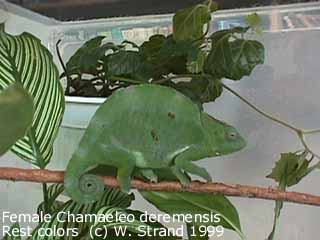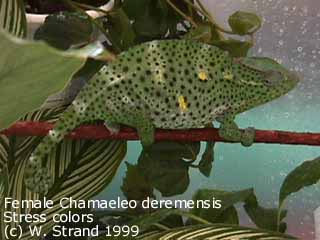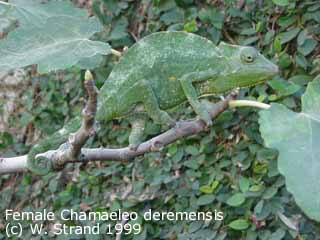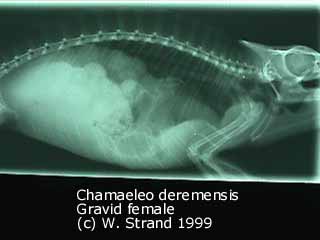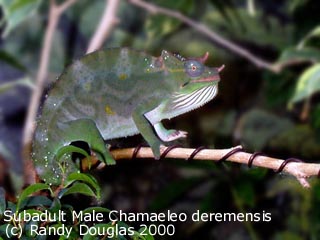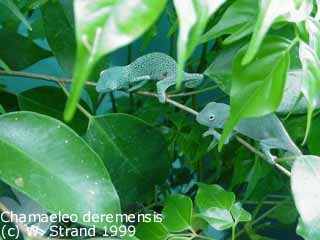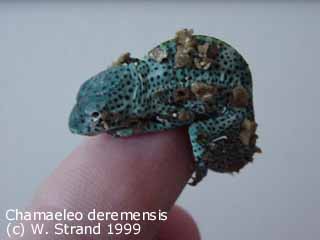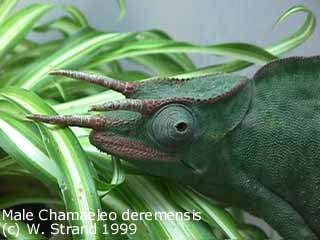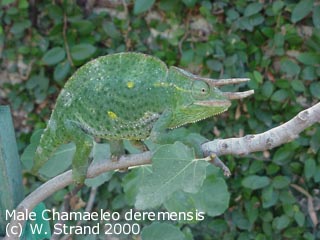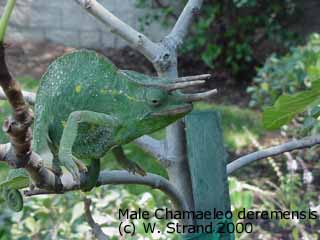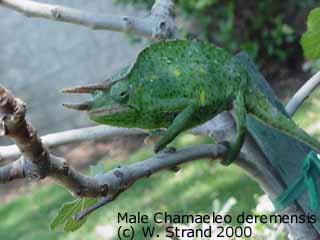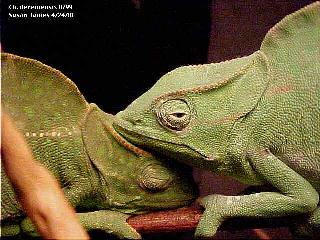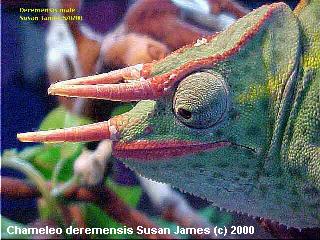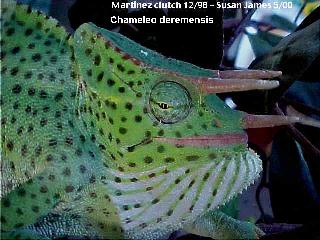C. deremensis inhabits the montane rain forests of Tanzania. It reaches 12-16 inches in total length and may weigh 120 - 150 grams. It is docile toward keepers but aggressive toward conspecifics.
This is said to be one of the more evolutionarily advanced chameleons due to their complex lung structure. They are a stocky species and have a short tail relative to the SVL length. The casque is unadorned; it is smooth, flattened and oblong and ends in a point bearing small, unfused occipital lobes. A short gular crest is present. Scalation is smooth. Body coloration for adults is medium to pale green with three or four pale yellow slashes that run in a broken line from behind the eye to midway down the body. A scattering of off- white, blue, red or brown patches and streaks are sometimes present. Excited/stress coloration sports a display of dark green or black spotting. The reverse of this pattern, ie.light spots on a dark green pattern can also be displayed. Hatchlings and young juveniles display the same patterns as adults but on an aqua blue background. Males possess three large annulated (ringed) horns. Female C. deremensis lack all traces of horns. Horn bud scales are not even present. Both sexes mature to a comparable size.
Because of their stringent requirements for reproduction and housing, only expert keepers should attempt to work with this species. C. deremensis prefer heavily planted cages and should be maintained separately in screened enclosures. Being a montane species, they prefer moderate to cool temperatures. Daytime highs should be in the low to mid 70s and night temperatures in the high 60s, accompanied by high humidity (80%+). This species seems to do best with an ultrasonic humidifier aimed directly at the cage and a constant flow of water dripping (usually directly overhead) on or near them. Babies and juveniles are especially likely to show signs of dehydration in warm temperatures if not kept well hydrated. Typically hearty eaters, males can somewhat decrease their food intake while greatly increasing their activity levels during the breeding season. One unusual trait of this species, particularly babies and juveniles, is their tendency to vibrate their entire bodies - a "shake and wiggle" just prior to shooting their tongue at a prey item. Spraying with warm water may also trigger eating. Feeding requirements are comparable to other chameleons of similar size. Caution should be advised against bowl feeding. They may station themselves over the bowl, rarely moving, becoming even more sedentary than normal. This species usually has a calm temperament in captivity but does seem to be happiest not being visible.
It is believed that this species does not produce viable, fertile eggs until the females second or third breeding season. Breeding season is thought to be in the fall, but may occur at any time of the year in captivity, perhaps due to environmental conditions (inconclusive). Breeding season, with numerous copulations, may last up to three months. Gestation is around four months. Twenty to 60 eggs are laid in a single clutch. Incubation is approximately four months at a temperature of 72F. Age of sexual maturity is unknown but is thought to be from 9-12 months.
References
Klaver, C. & W. Boehme. 1997. Chamaeleonidae.
Das Tierreich, 112: i-xiv' 1 - 85. Verlag Walter de Gruyter & Co., Berlin, New York.>
Martin, J., 1992. Masters of Disguise: A Natural History of Chameleons. Facts On File, Inc., New York, NY.
Necas, P. 1999. Chameleons: Nature's Hidden Jewels.
Krieger Publishing Company, Malabar, FL.
Spawls,
S., Howell, K., Drewes, R., and
Ashe, J. 2002. A Field Guide to
the Reptiles of East Africa. Academic Press, New York.
|

